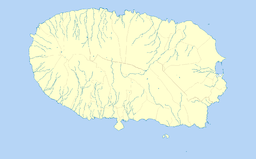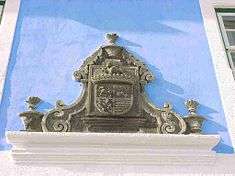Madre de Deus Manor
| Manor of Madre de Deus (Solar da Madre de Deus) | |
| Manor of the Mother of God | |
| Manorhouse (Solar) | |
| The location of the manorhouse in the foothills of the Angra do Heroísmo | |
| Named for: Mother of God (Virgin Mary) | |
| Country | |
|---|---|
| Autonomous Region | |
| Group | Central |
| Island | Terceira |
| Municipality | Angra do Heroísmo |
| Location | Sé |
| - coordinates | 38°39′27.40″N 27°13′27.96″W / 38.6576111°N 27.2244333°WCoordinates: 38°39′27.40″N 27°13′27.96″W / 38.6576111°N 27.2244333°W |
| Length | 44.75 m (147 ft), Southwest-Northeast |
| Width | 28.25 m (93 ft), Northwest-Southeast |
| Architects | unknown |
| Style | Baroque |
| Origin | 17th century |
| Acquired by the State | 1980s |
| Owner | Portuguese Republic |
| For public | Private |
| Visitation | Closed |
| Easiest access | Rua da Boavista, Rua da Madre de Deus |
| UNESCO World Heritage Site | |
| Name | Central Zone of the Town of Angra do Heroismo in the Azores |
| Year | 1983 (#7) |
| Number | 206 |
| Region | Europe and North America |
| Criteria | iv, vi |
| Management | Direção Regional de Cultura |
| Operator | Câmara Municipal de Angra do Heroísmo |
| Status | Property of Public Interest Imóvel de Interesse Público |
| Listing | Regional Government Presidential Resolution 41/1980; JORAA, Série I (20), 11 June 1980; Included in the urban centre of the City of Angra do Heroísmo (PT071901160035) |
 Location of the former-convent in the municipality of Angra do Heroismo
| |
| Wikimedia Commons: Solar da Madre de Deus (Angra do Heroísmo) | |
Manor of Madre de Deus (Portuguese: Solar da Madre de Deus) is a former manorhouse, historic landmark and residence in the civil parish of Sé, in the municipality of Angra do Heroísmo, in the Portuguese archipelago of the Azores.
History


The manor was constructed by the Majorat and Captain-major of Angra, João de Bettencourt de Vasconcelos, of the Bettencourt family, in the second-half of the 17th century, from a small residence whose principal facade was oriented towards the east (now the wall dividing the dining-room in the principal edifice).[1]
João de Bettencourt de Vasconcelos, along with his brother-in-law, Captain-major Francisco Ornelas da Câmara (who presided over the local Military War Council) used this building in 1641 during their blockade of the fortress of São João Baptista, and carved-out trenches around the building in order to defend the site.[1]
The small chapel at the site is dedicated to the invocation of Nossa Senhora da Madre de Deus (Our Lady the Mother of God) and was constructed in 1727, under the initiative of Vital de Bettencourt de Vasconcelos, the great-great grandson of João de Bettencourt.[1] The following year, on 15 June, the Bishop of Angra, D. Manuel Álvares da Costa, passed a charter to establish a cult, owing to "the parameters necessary, bell-tower and doorway towards the road".[1] This last detail implied that the hermitage was a public space, since the door was allows to be open to the those who wished to assist the religious services.[1]
The old gate, that gave rise to the patio, the fountain and the entranceway were part of the elaborate changes made by the older owners. Over the main doorway is the coat-of-arms of the Bettencourt family.[1]
The 1980 Azores earthquake caused serious damage to the internal structure of the building, demanding major repairs, consolidation of walls and restore of spaces.[1] Yet, owing to the expense, the family sold the estate to the State, which was restored and requalified to serve as the cabinet of the Ministry of the Republic in the Azores.[1]
The manor of Madre de Deus was classified as a Property of Public Interest by resolution 41/80 (11 June 1980), and included within the central zone of the historic centre of Angra do Heroísmo.[1][2]
Architecture
The former manorhouse is situated within the limits of the historic centre of Angra do Heroísmo, and is the current official residence and district centre of the Republican representative to the Azores. It is an example of the larger manorhouses that were constructed in the 17th century, that supported a large rural estate (that extended to the north of the residence).[1] This manor continued to be held by descendants until the 1980 Azores earthquake, when the former property-owners sold the building to the State.[1]
References
Notes
- 1 2 3 4 5 6 7 8 9 10 11 Noé, Paula (2012), SIPA, ed., Solar e Capela da Madre de Deus (IPA.00008162/PT071901100032) (in Portuguese), Lisbon, Portugal: SIPA – Sistema de Informação para o Património Arquitectónico, retrieved 18 August 2015
- ↑ "Resolução 41/80, 11 de Junho, e artigo 10.º e alínea a) do artigo 57.º do Decreto Legislativo Regional n.º 29/2004/A, de 24 de Agosto", Regime jurídico de protecção e valorização do património cultural móvel e imóvel (PDF) (in Portuguese), 24 August 2004, p. 5684
Sources
- Angra do Heroísmo: Janela do Atlântico entre a Europa e o Novo Mundo (in Portuguese), Horta (Faial), Portugal: Direcção Regional do Turismo dos Açores
- Dias, Pedro (2008), Arte de Portugal no Mundo - Açores (in Portuguese), Lisbon, Portugal: Péblico - Comunicação Social S.A.
